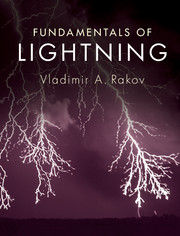Book contents
- Frontmatter
- Dedication
- Contents
- Preface
- 1 Types of lightning discharges and lightning terminology
- 2 Incidence of lightning to areas and structures
- 3 Electrical structure of thunderclouds
- 4 Properties of the downward negative lightning discharge to ground
- 5 Calculation of lightning electromagnetic fields
- 6 Modeling of the lightning return stroke
- 7 Measurement of lightning electric and magnetic fields
- 8 Electromagnetic methods of lightning location
- 9 Lightning damaging effects and protective techniques
- Appendices
- Appendix 1 How is lightning initiated in thunderclouds?
- Appendix 2 Reconstruction of sources from measured electrostatic field changes
- Appendix 3 Derivation of exact equations for computing lightning electric and magnetic fields
- Appendix 4 Compact intracloud discharges (CIDs)
- Appendix 5 Is it true that lightning never strikes the same place twice?
- Appendix 6 Is it possible to use lightning as an energy source?
- Appendix 7 Lightning safety
- Appendix 8 Lightning makes glass
- Appendix 9 Bibliography on triggered lightning experiments and natural lightning observations at Camp Blanding, Florida (1995–2014)
- Glossary
- References
- Index
Appendix 5 - Is it true that lightning never strikes the same place twice?
from Appendices
Published online by Cambridge University Press: 05 April 2016
- Frontmatter
- Dedication
- Contents
- Preface
- 1 Types of lightning discharges and lightning terminology
- 2 Incidence of lightning to areas and structures
- 3 Electrical structure of thunderclouds
- 4 Properties of the downward negative lightning discharge to ground
- 5 Calculation of lightning electromagnetic fields
- 6 Modeling of the lightning return stroke
- 7 Measurement of lightning electric and magnetic fields
- 8 Electromagnetic methods of lightning location
- 9 Lightning damaging effects and protective techniques
- Appendices
- Appendix 1 How is lightning initiated in thunderclouds?
- Appendix 2 Reconstruction of sources from measured electrostatic field changes
- Appendix 3 Derivation of exact equations for computing lightning electric and magnetic fields
- Appendix 4 Compact intracloud discharges (CIDs)
- Appendix 5 Is it true that lightning never strikes the same place twice?
- Appendix 6 Is it possible to use lightning as an energy source?
- Appendix 7 Lightning safety
- Appendix 8 Lightning makes glass
- Appendix 9 Bibliography on triggered lightning experiments and natural lightning observations at Camp Blanding, Florida (1995–2014)
- Glossary
- References
- Index
Summary
The most common type of lightning discharge between a thundercloud and Earth's surface, which accounts for 90 percent of all lightning discharges involving ground, begins in the cloud. Before the brilliant lightning channel bridges the gap, a lightning process called a “leader” takes place. This process creates a downward branched, low-luminosity channel, not observable with a naked eye or with an ordinary photographic camera. The leader channel extends from the cloud in search for a termination point on the ground. If we consider a terrain that is essentially flat and geologically uniform, the lightning termination point on the ground can be viewed as random. In this case, the saying “lightning never strikes the same place twice” would be essentially true, as illustrated next. A small area of one square meter in an open field in Florida is struck by lightning on average once every 100 millennia. Thus, it is highly unlikely that one can see two lightning strikes to that 1 m2 area; for all practical purposes this is equivalent to never. It is worth noting that each lightning flash is typically composed of three to five component strokes that usually retrace the same channel to ground. However, these component strokes occur within a second or less and can be detected by a naked eye only as the flickering in luminosity of the lightning channel.
In reality, ground is not homogeneous and, as a result, the descending lightning leader will be attracted to some terrain features more than to others. Grounded metallic objects dominating the area are more likely to be struck by lightning than the surrounding ground or lower structures nearby (this is how lightning rods work). In general, the taller the object, the more often it is struck. For example, a 60 m tower located in Florida is expected to be struck by lightning roughly between once every other year and once every year. As the height of an object increases beyond 100 m or so, a different type of lightning discharge to this object can occur in addition to the type described above. This additional type of lightning also involves a leader process, but the leader channel originates on the object and extends toward the cloud.
Information
- Type
- Chapter
- Information
- Fundamentals of Lightning , pp. 212Publisher: Cambridge University PressPrint publication year: 2016
